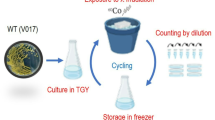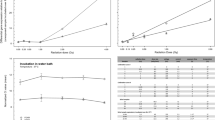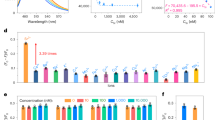Abstract
We show that the non–radioactive reagent, photobiotin, can replace the use of radioactivity in preparing gene probes for Southern, Northern and DNA dot–blot analyses. Using a photobiotin–labeled probe, the single copy human metallothionein IIA (MT IIA) gene is readily detected in genomic DNA by Southern transfer. Similarly, low abundance chicken histone H5 mRNA is easily detected in total cytoplasmic RNA isolated from an erythroleukemic cell line by Northern analysis. Finally, a photobiotin–labeled fragment of the pig growth hormone gene is used to detect the presence of this gene in transgenic mice by dot–blot analysis.
This is a preview of subscription content, access via your institution
Access options
Subscribe to this journal
Receive 12 print issues and online access
$259.00 per year
only $21.58 per issue
Buy this article
- Purchase on SpringerLink
- Instant access to full article PDF
Prices may be subject to local taxes which are calculated during checkout
Similar content being viewed by others
References
Weatherall, D.J. 1985. The New Genetics and Clinical Practice (2nd Edition). Oxford University Press, Oxford, U.K.
Wallace, R.B., Studencki, A.B. and Murasugi, A. 1985. Application of synthetic oligonucleotides to the diagnosis of human genetic diseases. Biochimie 67: 755–762.
Highfield, P.E. and Dougan, G. 1985. DNA probes for microbial diagnosis. Med. Lab. Sci. 42: 352–360.
Pettersson, U. and Hyypia, T. 1985. Nucleic acid hybridization—an alternative tool in diagnostic microbiology. Immunol. Today 6: 268–272.
Renz, M. 1983. Polynucleotide-histone H1 complexes as probes for blot hybridization. EMBO J. 2: 817–822.
Renz, M. and Kurz, C. 1984. A colorimetric method for DNA hybridization. Nucl. Acids Res. 12: 3435–3444.
Landegent, J.E., Jansen in de Wal, N., Baan, R.A., Hoeijmakers, J.H.J. and Van der Ploeg, M. 1984. 2-Acetylaminofluorene modified probes for the indirect hybridocytochemical detection of specific nucleic acid sequences. Exp. Cell Res. 153: 61–72.
Tchen, P., Fuchs, R.P.P., Sage, E. and Leng, M. 1984. Chemically modified nucleic acids as immunodetectable probes in hybridization experiments. Proc. Natl. Acad. Sci. USA 81: 3466–3470.
Forster, A.C., McInnes, J.L., Skingle, D.C. and Symons, R.H. 1985. Nonradioactive hybridization probes prepared by the chemical labelling of DNA and RNA with a novel reagent, photobiotin. Nucl. Acids Res. 13: 745–761.
Syvanen, A.-C., Alanen, M. and Soderlund, H. 1985. A complex of single-strand binding protein and M13 DNA as hybridization probe. Nucl. Acids Res. 13: 2789–2803.
Viscidi, R.P., Connelly, C.J. and Yolken, R.H. 1986. Novel chemical method for the preparation of nucleic acids for nonisotopic hybridization. J. Clin. Micro. 23: 311–317.
Langer, P.R., Waldrop, A.A. and Ward, D.C. 1981. Enzymatic synthesis of biotin-labelled polynucleotides: novel nucleic acid affinity probes. Proc. Natl. Acad. Sci. USA 78: 6633–6637.
Leary, J.J., Brigati, D.J. and Ward, D.C. 1983. Rapid and sensitive colorimetric method for visualizing biotin-labelled DNA probes hybridized to DNA or RNA immobilized on nitrocellulose: Bio-blots. Proc. Natl. Acad. Sci. USA 80: 4045–4049.
Karin, M. and Richards, R.I. 1982. Human metallothionein genes-primary structure of the metallothionein-II gene and a related processed gene. Nature 299: 797–802.
Southern, E.M. 1975. Detection of specific sequences among DNA fragments separated by gel electrophoresis. J. Mol. Biol. 98: 503–517.
Krieg, P.A., Robins, A.J., D'Andrea, R. and Wells, J.R.E. 1983. The chicken H5 gene is unlinked to core and H1 histone genes. Nucl. Acids Res. 11: 619–627.
Focus (Bethesda Research Laboratories/Life Technologies Inc.) 1985. 7:(2), 11.
Beug, H., Doederlein, G., Freudenstein, C. and Graf, T. 1982. Erythroblast cell lines transformed by a temperature-sensitive mutant of avian erythroblastosis virus: a model system to study erythroid differentiation in vitro. J. Cell. Physiol. 1: 195–207.
Dalton, S., Coleman, J.R. and Wells, J.R.E. 1986. Transcription of the histone H5 gene is not S-phase regulated. Mol. Cell. Biol. 6: 601–606.
Powell, P.C., Payne, L.N., Frazier, J.A. and Rennie, M. 1974. T lymphoblastoid cell lines from Marek's disease lymphomas. Nature 251: 79–80.
Melton, D.A., Krieg, P.A., Rebagliati, M.R., Maniatis, T., Zinn, K. and Green, M.R. 1984. Efficient in vitro synthesis of biologically active RNA and RNA hybridization probes from plasmids containing a bacteriophage SP6 promoter. Nucl. Acids Res. 12: 7035–7056.
Syvanen, A.-C., Laaksonen, M. and Soderlund, H. 1986. Fast quantification of nucleic acid hybrids by affinity-based hybrid collection. Nucl. Acids Res. 14: 5037–5048.
Garbutt, G.J., Wilson, J.T., Schuster, G.S., Leary, J.J. and Ward, D.C. 1985. Use of biotinylated probes for detecting sickle cell anaemia. Clin. Chem. 31: 1203–1206.
Pollice, M. and Yang, H.-L. 1985. Use of nonradioactive DNA probes for the detection of infectious bacteria. Clin. Lab. Med. 5: 463–473.
Chan, V.T.-W., Fleming, K.A. and McGee, J.O'D. 1985. Detection of subpicogram quantities of specific DNA sequences on blot hybridization with biotinylated probes. Nucl. Acids Res. 13: 8083–8091.
Gross-Bellard, M., Oudet, P. and Chambon, P. 1973. Isolation of high-molecular-weight DNA from mammalian cells. Eur. J. Biochem. 36: 32–38.
Wahl, G.M., Stern, M. and Stark, G.R. 1979. Efficient transfer of large DNA fragments from agarose gels to diazobenzyloxymethyl-paper and rapid hybridization by using dextran sulphate. Proc. Natl. Acad. Sci. USA 76: 3683–3687.
Aviv, H. and Leder, P. 1972. Purification of biologically active globin messenger RNA by chromatography on oligothymidylic acid-cellulose. Proc. Natl. Acad. Sci. USA 69: 1408–1412.
Thomas, P.S. 1983. Hybridization of denatured RNA transferred or dotted to nitrocellulose paper. Meth. Enzymol. 100: 255–266.
Author information
Authors and Affiliations
Rights and permissions
About this article
Cite this article
McInnes, J., Dalton, S., Vize, P. et al. Non–Radioactive Photobiotin–Labeled Probes Detect Single Copy Genes and Low Abundance mRNA. Nat Biotechnol 5, 269–272 (1987). https://doi.org/10.1038/nbt0387-269
Received:
Accepted:
Issue date:
DOI: https://doi.org/10.1038/nbt0387-269
This article is cited by
-
Hordeum chilense repetitive sequences. Genome characterization using biotinylated probes
Theoretical and Applied Genetics (1990)
-
Human Satellite III DNA: Genomic location and sequence homogeneity of the TaqI-deficient polymorphic sequences
Chromosoma (1989)
-
In situ hybridization of messenger RNA sequences
The Histochemical Journal (1989)



